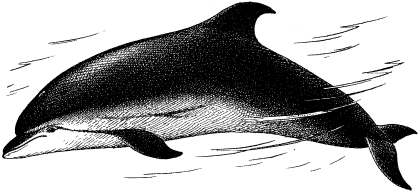
Tursiops truncatus Montagu, 1821

Synonyms: Tursiops truncatus ponticus Barabasch-Nikiforov, 1940
Common names: Engl: Bottlenose dolphin; Bulg: Afala; Georg: Aphalina; Rom: Afalin, Delfinul cu bot de sticla, Delfinul cu bot gros; Russ: Afalina chernomorskaya; Turk: Afalina; Ukr: Afalina chornomors'ka
Order: CETACEA
Family: DELPHINIDAE
Taxonomic descriptions: It is a single representative
of the genus and one of two Delphinidae species in the Black Sea. In scientific literature
belonging to ex-Soviet authors this animal is mentioned usually as the endemic sub-species
T.truncatus ponticus, but no indisputable proofs were published till now to support
this opinion.
External distinctions: moderate-length snout separated from the melon by distinct crease;
tall, falcate dorsal fin; robust conical teeth partially worn in old animals.
 IUCN Status:
IUCN Status:
World level: DD
Black Sea Regional level: DD
Subregion level: EN in Romania, VU in
Bulgaria and Ukraine
Distribution:
Habitats type, Critical habitats, Limiting factors: Bottlenose dolphins could be found sometimes and somewhere all over the waters of the Black Sea continental shelf, occasionally they occur offshore, and, very rarely in the Sea of Azov. There are no exact data on resident dolphin schools, although groups of foraging animals may stay in some places off the Crimean, Caucasian and Anatolian coasts for a few days to several months. Dolphins annually form more or less compact accumulations in the Kerch Strait and adjacent forestrait zone from early spring to late autumn. Herd migrations (sometimes of several hundred animals) are known along the south coast of the Crimea in autumn, but migratory routes should be studied much more thoroughly, including, in particular, the Turkish straits system - the single path for probable genetic exchange between Black Sea and Mediterranean Sea populations. The Kerch Strait and the Bosphorus, and contiguous waters are the most critical places for cetacean movements and sedentary habitation because of strong local antropogenic pressure caused by various “beneficial” activities. The peculiarities of bottlenose dolphin reproduction mentioned below seem to be the main natural factor limiting population growth.
Biology: It is the biggest (up to 3.3 m long) Black Sea cetacean with relatively prolonged life cycle (perhaps about 25-30 years) and quite low fertility. Females become mature earlier (by 5-6, maximum 12 years old) than males (8-12 years). Sexual behaviour could be observed during the whole year with a peak in spring-early summer. The 12-months long gestation periods take turns with barren intervals continuing from 2-3 to six years. The parturition results usually in one calf. The lactation period varies from four months to 1.5 year. Most benthic and pelagic fish species, both small and big, are suitable prey, including Black Sea scad, herring, anchovy, whiting, turbot, grey and striped mullet, red mullet, bonito, etc. In recent years the acclimatized Far East mullet (Mugil so-iuy) has became the preferred prey during its stock migrations off the Crimea. Each dolphin consumes 6-32 kg of fish per diem.
Population trends: The bottlenose dolphin population is always estimated as smaller than the other Black Sea cetacean populations. In the 20th century, up to the early 1980s, it was reduced by mass direct kills for the dolphin-processing industry which was highly developed in the USSR and Turkey. Today there are no any strict scientific data on population abundance.
Threats: Incidental catching in fishing nets; disturbance caused by extensive cabotage traffic; habitat limitation as a result of chronic pollution and artificial freshening of former feeding areas, e.g., Karkinit Bay in Ukraine. Since the 1960s hundreds of bottlenose dolphins were taken alive in the Soviet Union (mainly) and Romania for scientific, military and commercial needs. The Russian Federation and Ukraine are continuing that practice periodically in Taman’ Bay and near the southern coast of the Crimea.
Conservation measures taken: Industrial dolphin killing has been prohibited in Bulgaria, Georgia, Romania, Russian Federation, and Ukraine since 1966, and since 1983 in Turkey. During the 1980s the Black Sea T. truncatus was entered in the national Red Data Books of Georgia, Russia, Bulgaria and Ukraine. On the international level this species is protected by the Berne, Bonn and Washington (CITES) conventions (it is listed in their Appendices II), the IUCN Red Data Book, and since November 1996 by the multilateral Agreement on the Conservation of Cetaceans of the Black Sea, Mediterranean Sea and Contiguous Atlantic Area (ACCOBAMS). The Black Sea population is mentioned as the endangered in the UNEP Global Action Plan on Marine Mammals. A number of other intergovernmental and international nongovernmental organizations pay their attention to bottlenose dolphins conservation.
Conservation measures proposed: Adoption of ACCOBAMS by all Black Sea states; design and implementation of a regional Black Sea program for marine mammal populations conservation including a bottlenose dolphin stock assessment, organizing of specially protected areas, enhancement of rescue and rehabilitation activities for sick and traumated animals. Any other deliberate catching of wild cetaceans should be stopped completely.
References:
Compiled by: A.Birkun, Jr., M.Moldoveanu, M.Stanciu, T.Stanev, B.Öztürk, A.Komakhidze